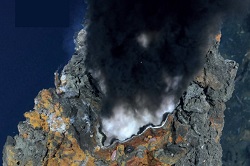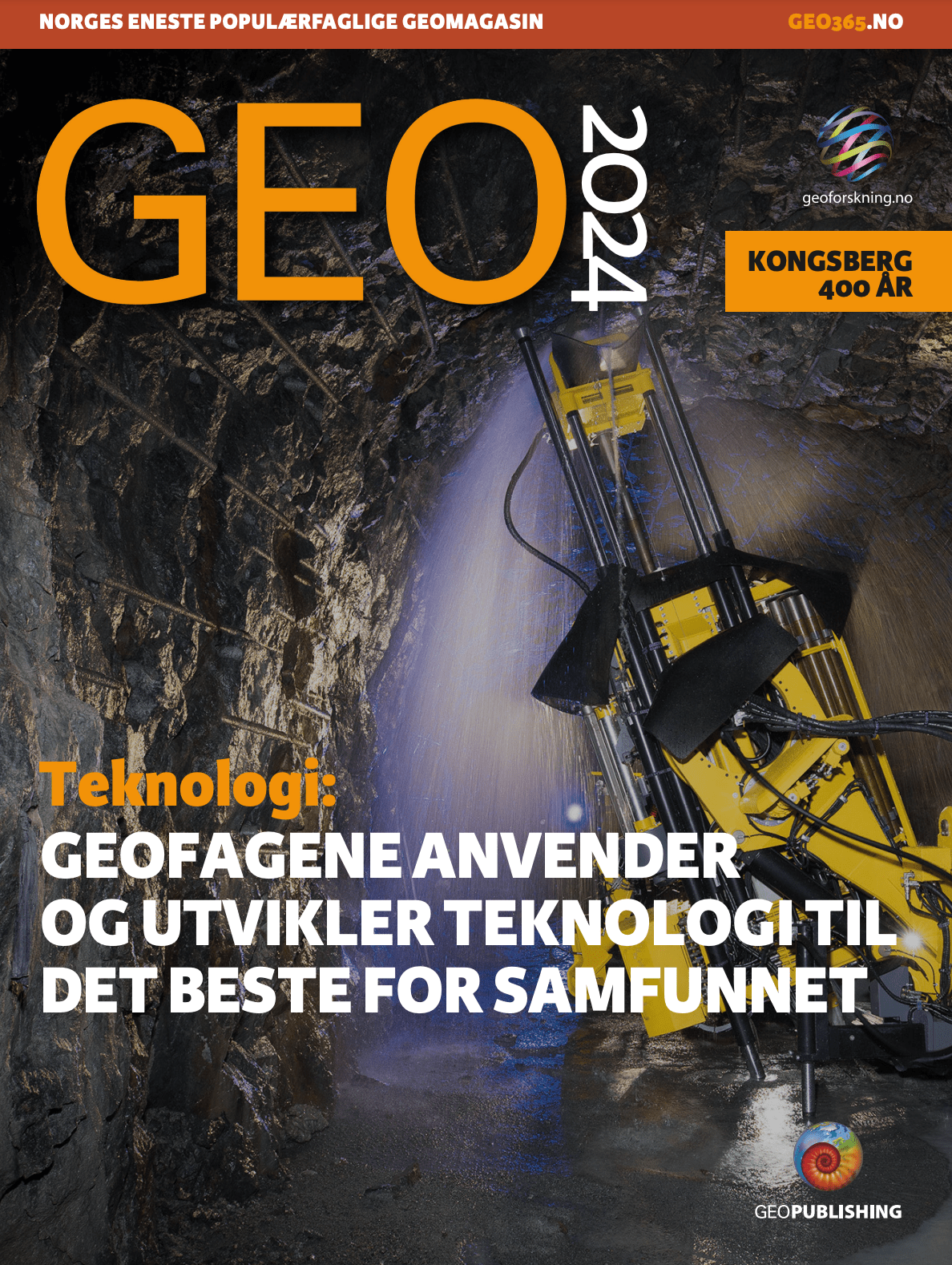Massive sulphides are formed as a result of boiling hot, mineral-rich water cooling down and depositing metals and minerals in and near chimneys on the seabed.
 This photo shows a chimney found within the crater of a marine volcano between Fiji and Samoa. Photo: GEOMAR / Schmidt Ocean Institute / CSSF
This photo shows a chimney found within the crater of a marine volcano between Fiji and Samoa. Photo: GEOMAR / Schmidt Ocean Institute / CSSF
Hydrothermal vents («black smokers») are spectacular sights. They were first observed in 1979 and are found in volcanic active areas in the deep sea (between 1,000 – 4,000 meters depth), primarily along spreading ridges.
In Norwegian waters, we know of several fields with active chimneys along the Mohns Ridge and the Knipovich Ridge between Jan Mayen and Svalbard.
The black «smoke» that seeps out of the chimneys consists of boiling hot mineral-rich water that has circulated in cracks near magma chambers two to three kilometers below the seabed.
Chemical processes turn the water slightly acidic and able to dissolve and absorb certain metals and elements from the rocks it penetrates. The high temperature (up to 400 °C) gives the water buoyancy.
As the water reaches the seabed and the cold seawater, it cools rapidly. It then loses its ability to hold the metals and minerals (sulphides), which quickly precipitates.
It is this precipitation that over time build up the chimneys. Precipitation also takes place around the chimneys, which over time can build large gravel piles rich in sulphides. The chimneys and sulphide mounds form massive sulphides (SMS, seafloor massive sulphides), metal deposits that may prove to be economically recoverable.
The sulphides usually consist of copper, zinc, iron, gold and silver. The grades vary from locality to locality. Sampling of a chimney along the Mid-Atlantic ridge west of Africa yielded the following levels:
Copper 4.9%
Zinc: 7.7%
Lead: 0.2%
Iron: 26.9%
Gold: 1.2 grams / ton
These grades exceed what we find in most mines on land today. However, a chimney sampled in the Manus Basin off Papua New Guinea yielded even higher grades:
Copper: 8.3%
Zinc: 15.8%
Lead: 1.6%
Iron: 9.9%
Gold: 12.5 grams / ton
READ ALSO: Stor variasjon i gehalter
However, high grades do not necessarily constitute an economic deposit – the resources must be defined in sufficient volumes. As of today, there are only a few deposits in the world that have been classified as economically recoverable.
Research has shown that the metal grades of massive sulphides are largely controlled by the geological setting. Occurrences in areas where there are faults extending from the spreading ridge and where rocks from the upper mantle are exposed, have higher grades.
However, the content of rare metals and trace elements will vary greatly from locality to locality and will largely depend on local conditions.
Deep sea exploration companies must also take into account large variations in grades between the outside and inside of a chimney, as well as between chimneys and gravel piles.
Good resource estimates will thus require drilling. Globally, we have very few drill cores from massive sulphides, and estimates of how large the world’s SMS resources are, are uncertain.
 Processes at hydrothermal sites in the deep sea. Illustration: GEOMAR (Mineral Resources of the Deep Sea)
Processes at hydrothermal sites in the deep sea. Illustration: GEOMAR (Mineral Resources of the Deep Sea)
Exploration and recovery
90 percent of the sulphide deposits we know today are too small to be economically recoverable. However, there is lots of improvements to be done in terms of exploration technology.
Until now, discoveries of hydrothermal vents have been made by tracing small particles in the water column that originate from an active chimney. This exploration method does not work on older, inactive chimney fields that may be larger and more mature.
Extraction of raw materials from the deep sea poses technical and logistical challenges. So far, most of the possible technologies and methods exist only on the drawing board as concepts. However, some equipment and some systems have been developed.
Massive sulphides require splitting of solid rock. Deep-sea robots (rock cutters) that operate in the same fashion as tunnel boring machines can break sulphides into smaller rocks.
These rocks can then be collected by other machines (collectors) and pumped up to a production ship via a pipe. The ship sorts the ore and sends water and sediments back into the sea. A transport ship picks up the ore from the production ship.
Deep Sea Mining Finance (DSMF) plans to extract massive sulphides at the Solwara 1 deposit off the coast of Papua New Guinea using the method described above.
John Parianos of DSMF will speak at the NCS Exploration – Deep Sea Minerals conference on October 20 and 21.



